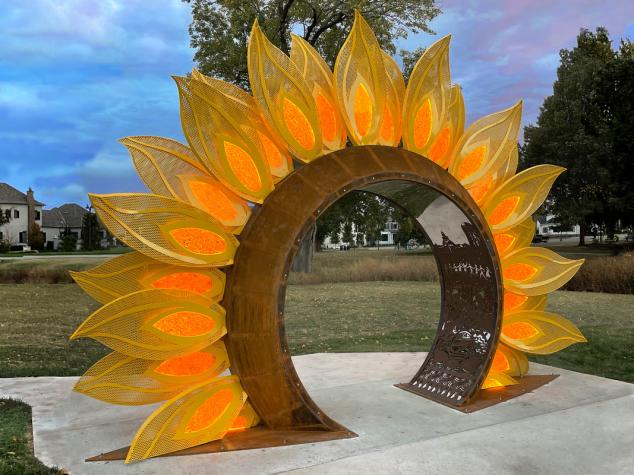University of Missouri Extension’s Urban West Region is partnering with ArtsKC to develop a comprehensive asset map and online arts inventory for the five-county Kansas City metro region. The ArtsKC Regional Arts Impact Dashboard helps to:
- Engage communities around the arts.
- Document the economic and cultural impact of the arts.
- Strengthen neighborhood and regional economic, community development and educational opportunities around the arts.
- Build advocacy for supporting the arts.
“People tend to focus on the value of the arts being that they connect people and make for more vibrant and interesting places to live,” says GK Callahan, extension engagement specialist in the Urban West Region. “What this project does is make clear the big-picture economic impact — and the potential for growth.”
Who
GK and Elena Stephenson, a community development specialist in Jackson County, have mapped existing arts assets in Kansas City and Jackson, Clay and Johnson counties. Work in Wyandotte and Platte counties continues this year. With MU CARES, GK and Elena have vetted quantitative and qualitative data to add to the ArtsKC Regional Arts Impact Dashboard.
How
For each county, GK and Elena, with CARES support, collect and review:
- Cultural Arts Inventory data.
- EMIS data for art industries.
- Publicly available IRS tax-exempt organizations, arts, culture and humanities data.
Then, they:
- Conduct in-person focus groups.
- Administer online surveys.
- Validate assets (more than 1,400 assets in the region have been identified to date).
CARES maps the qualitative assets to combine with ArtsKC’s regional and county-specific dashboards.
Why is data collection important?
- Leads to better understanding of local, county, regional creative industries.
- Empowers communities to identify local assets and “hidden gems” meaningful to them.
- Influences county and municipal decisions and funding.
- Shows regional gaps in assets, services, funding and resources.
Elena: “Asset mapping provides this cool synergy of quantitative and qualitative data. You can really show leaders how much economic and social vitality the arts are bringing to the community. Mapping also points the way toward how to build upon what is already in place.
“It helps with big projects and understanding the role the arts play in community and economic development.”
GK: “I also hope artists, teachers and smaller nonprofits can use the data to advocate for the work they are doing: ‘I want to take my students on a field trip. How do I find local artists?’ ‘I want to do a community mural. Who do I need to get permission from?’
“The data also can help us discover stories. For instance, much of the existing arts infrastructure sits along the Kansas City urban corridor. Yet, a lot of the wealth sits in Jackson County’s eastern rural areas. If you’re a traveling playhouse or you’re looking for a second location for your thriving creative business, bringing those assets to where the money is but where there’s a dearth of cultural assets could be a really easy win. That’s a story the data can help tell.”
Why MU Extension?
“ArtsKC came to us because you need buy-in to get the community’s voice,” GK says. “MU Extension is already embedded in the community and has connections and credibility. Elena and I also are artists ourselves here,” GK says.
What do partners in the process think?
Sarah VanLanduyt, executive director, Arts Council of Johnson County, Overland Park, Kan.
“This process was really fun and a great public-private, two-state, several-county partnership. We are a big fan of community-driven projects: ‘Who are we missing? Are there underrepresented groups who should be at the table?’
“We can now point to data to say, in Johnson County alone, the arts have over a $33 million economic impact. That’s jobs, reinvestment in communities, small business startups and new entrepreneurs. This knowledge creates a foundation upon which to grow and a way to strategically market and promote awareness within the five-county region.”
Michael Baxley, executive director, Englewood Arts, Independence, Mo.
“The arts inventory and asset-mapping tools have already proven valuable in our Englewood Arts Zoning Overlay initiative. The initiative seeks to amend certain Independence zoning restrictions to make for a more arts friendly area: for instance, allowing artists to do things like having a studio or gallery in their homes or approved space for outdoor sculptures. The data have helped us make our case with community members, at town meetings and for our upcoming presentation to the planning commission in May.
“Generally, as a nonprofit organization, you always want to be able to measure and share your impact with donors and funders. Sometimes documenting the work, as this asset-mapping and inventory process has done, can be as important as the work itself in creating an appreciation and support for a thriving arts presence.”
For more information about the Arts Asset Mapping process, MU Extension faculty and staff can contact GK Callahan and Elena Stephenson.
For questions about All Things Missouri and data-mapping, contact Jamie Kleinsorge at kleinsorgej@missouri.edu.
Original author: Katherine Foran
